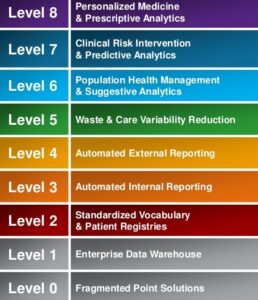The Eight Levels of the Analytics Adoption Model
By Dale Sanders
Level 8 – Personalized Medicine & Prescriptive Analytics
Contracting for & managing health
Personalized Medicine & Prescriptive Analytics:
- Analytic motive expands to wellness management, physical and behavioral functional health, and mass customization of care.
- Analytics expands to include NLP of text, prescriptive analytics, and interventional decision support.
- Prescriptive analytics are available at the point of care to improve patient specific outcomes based upon population outcomes.
- Data content expands to include 7×24 biometrics data, genomic data and familial data.
- The EDW is updated within a few minutes of changes in the source systems.
Level 7 – Clinical Risk Intervention & Predictive Analytics
Taking more financial risk & managing it proactively
Clinical Risk Intervention & Predictive Analytics:
- Analytic motive expands to address diagnosis-based, fixed-fee per capita reimbursement models.
- Focus expands from management of cases to collaboration with clinician and payer partners to manage episodes of care, using predictive modeling, forecasting, and risk stratification to support outreach, triage, escalation and referrals.
- Physicians, hospitals, employers, payers and members/patients collaborate to share risk and reward (e.g., financial reward to patients for healthy behavior).
- Patients are flagged in registries who are unable or unwilling to participate in care protocols.
- Data content expands to include home monitoring data, long term care facility data, and protocol-specific patient reported outcomes.
- On average, the EDW is updated within one hour or less of source system changes.
Level 6 – Population Health Management and Suggestive Analytics
Taking financial risk and preparing your culture for the next levels of analytics
Population Health Management & Suggestive Analytics:
- The “accountable care organization” shares in the financial risk and reward that is tied to clinical outcomes.
- At least 50% of acute care cases are managed under bundled payments.
- Analytics are available at the point of care to support the Triple Aim of maximizing the quality of individual patient care, population management, and the economics of care.
- Data content expands to include bedside devices, home monitoring data, external pharmacy data, and detailed activity based costing.
- Data governance plays a major role in the accuracy of metrics supporting quality-based compensation plans for clinicians and executives.
- On average, the EDW is updated within one day of source system changes.
- The EDW reports organizationally to a C-level executive who is accountable for balancing cost of care and quality of care.
Level 5 – Waste & Care Variability Reduction
Measuring & managing evidence based care
Clinical Effectiveness & Accountable Care:
- Analytic motive is focused on measuring adherence to clinical best practices, minimizing waste, and reducing variability.
- Data governance expands to support care management teams that are focused on improving the health of patient populations.
- Population-based analytics are used to suggest improvements to individual patient care.
- Permanent multidisciplinary teams are in-place that continuously monitor opportunities to improve quality, and reduce risk and cost, across acute care processes, chronic diseases, patient safety scenarios, and internal workflows.
- Precision of registries is improved by including data from lab, pharmacy, and clinical observations in the definition of the patient cohorts.
- EDW content is organized into evidence-based, standardized data marts that combine clinical and cost data associated with patient registries.
- Data content expands to include insurance claims (if not already included) and HIE data feeds.
- On average, the EDW is updated within one week of source system changes.
Level 4 – Automated External Reporting
Efficient, consistent production and agility
Automated External Reporting:
- Analytic motive is focused on consistent, efficient production of reports required for regulatory and accreditation requirements (e.g. CMS, Joint Commission, tumor registry, communicable diseases); payer incentives (e.g. MU, PQRS, VBP, readmission reduction); and specialty society databases (e.g. STS, NRMI, Vermont-Oxford).
- Adherence to industry-standard vocabularies is required.
- Clinical text data content is available for simple key word searches.
- Centralized data governance exists for review and approval of externally released data.
Level 3 – Automated Internal Reporting
Efficient, consistent production
Automated Internal Reporting:
- Analytic motive is focused on consistent, efficient production of reports supporting basic management and operation of the healthcare organization.
- Key performance indicators are easily accessible from the executive level to the front-line manager.
- Corporate and business unit data analysts meet regularly to collaborate and steer the EDW.
- Data governance expands to raise the data literacy of the organization and develop a data acquisition strategy for Levels 4 and above.
Level 2 – Standardized Vocabulary & Patient Registries
Relating and organizing the core data
Standardized Vocabulary & Patient Registries:
- Master vocabulary and reference data identified and standardized across disparate source system content in the data warehouse.
- Naming, definition, and data types are consistent with local standards.
- Patient registries are defined solely on ICD billing data.
- Data governance forms around the definition and evolution of patient registries and master data management.
Level 1 – Enterprise Data Warehouse
Foundation of data and technology
Enterprise Data Warehouse:
- At a minimum, the following data are co-located in a single data warehouse, locally or hosted: HIMSS EMR Stage 3 data, Revenue Cycle, Financial, Costing, Supply Chain, and Patient Experience.
- Searchable metadata repository is available across the enterprise.
- Data content includes insurance claims, if possible.
- Data warehouse is updated within one month of source system changes.
- Data governance is forming around the data quality of source systems.
- The EDW reports organizationally to the CIO.
Category: Uncategorized

